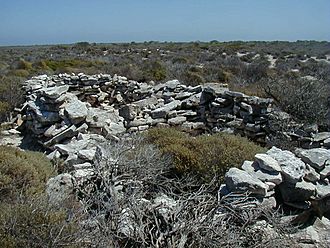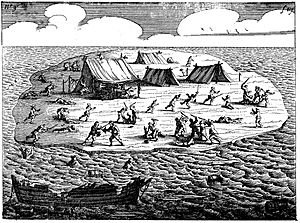Wiebbe Hayes Stone Fort facts for kids
Quick facts for kids Wiebbe Hayes Stone Fort |
|
|---|---|

The fort in 2001
|
|
| General information | |
| Type | Defensive structure |
| Location | West Wallabi Island |
| Country | Australia |
| Coordinates | 28°27′41″S 113°42′15″E / 28.4613357°S 113.7041114°E |
| Construction started | 1629 |
| Official name | Ruins of Two Stone Huts |
| Type | Heritage Council |
| Designated | 31 July 1995 |
| Part of | Houtman Abrolhos Islands |
| Reference no. | 3990 |
| Official name | Batavia Shipwreck Site and Survivor Camps Area 1629 |
| Type | Historic |
| Criteria | A, C, D, G |
| Designated | 6 April 2006 |
| Reference no. | 105887 |
The Wiebbe Hayes Stone Fort is a very old building on West Wallabi Island in Australia. It is known as the oldest European building still standing in Australia. This fort was built in 1629 by people who survived a terrible shipwreck and difficult times afterwards. West Wallabi Island is about 63 km (39 mi) from the coast of Western Australia.
Contents
The Story of the Fort
Shipwreck and Survival
In 1629, a Dutch ship called the Batavia crashed on a reef near the Houtman Abrolhos Islands. Many people survived the shipwreck. Among them were soldiers led by a man named Wiebbe Hayes.
Finding Water and Food
Wiebbe Hayes and his soldiers were sent to West Wallabi Island to look for fresh water. A group of people who had taken control of the other survivors secretly hoped the soldiers would not find anything and would die. But the soldiers were clever! They found they could walk through shallow water to East Wallabi Island. There, they discovered a spring with fresh water.
They also found food. West and East Wallabi Islands are the only islands in that area where the tammar wallaby lives. This meant the soldiers had both water and food, which the other group did not have.
Building for Protection
Later, the group who had taken control of the main camp attacked Wiebbe Hayes' soldiers. The soldiers fought back and defended themselves. To stay safe, Wiebbe Hayes and his men built simple walls and shelters using loose rocks. These structures are what we now call the Wiebbe Hayes Stone Fort.
Australia's Oldest European Building
The remains of these stone walls and shelters on West Wallabi Island are Australia's oldest known European buildings. They were built more than 150 years before famous explorers like James Cook and Arthur Phillip arrived in Australia.
Today, the fort looks like a small, simple rectangle of rocks in the bushes. It's about 100 metres [110 yd] from the sea. Even though it's just piled-up rocks, it's a very important piece of history. It shows us the first building Europeans ever made in Australia.


